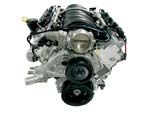
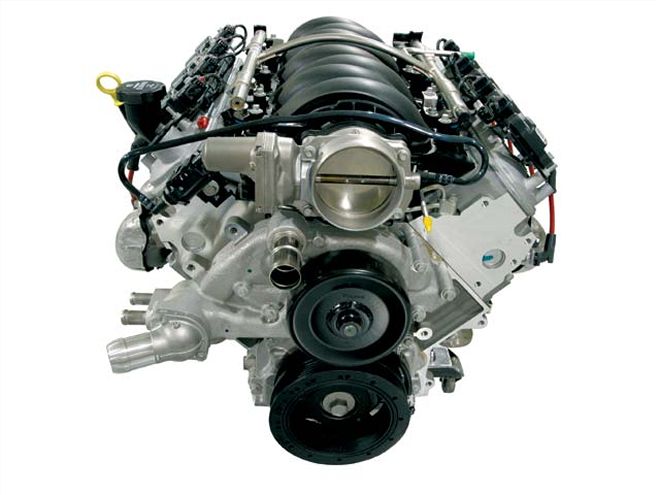
General Motors' new LS2 small-block, which debuted in '05 Corvettes, GTOs, and selected SSR pickups, is something of an odd breed. Dubbed a Gen IV, the biggest physical differences between it and its predecessors are a new all-aluminum 6.0L block designed to accommodate GM's Displacement on Demand (DOD) cylinder deactivation technology, and the relocation of a few key sensors including the cam position and MAP sensors (see "Gen Four," Mar. '05). But since the '05 version of the LS2 doesn't have DOD, and many of its key parts are actually carry-overs from previous-generation LS6s, including the cylinder head castings and camshaft specs, it could almost be called a Gen III1?2.
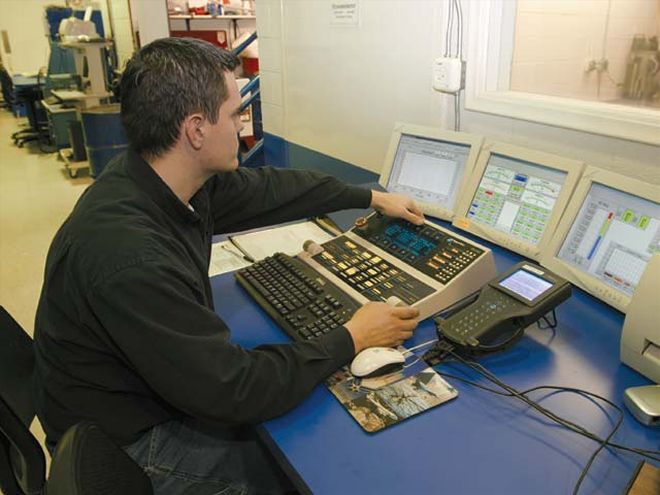 Katech's Mark Sanderson worked the throttle knob for all our testing. Note the GM Tech II scanner next to the console that's hooked up to the ECU to watch what it's doing with spark timing during the runs.
Katech's Mark Sanderson worked the throttle knob for all our testing. Note the GM Tech II scanner next to the console that's hooked up to the ECU to watch what it's doing with spark timing during the runs.
Last month in Part I, we highlighted many of the subtle differences between the Gen IV LS2 and its Gen III LS1 and LS6 brethren. This month, again with the help of Mark McPhail, director of street performance at Katech Engine Development, we're back to put the new LS2 through its paces on the dyno and see just how receptive the new engine is to the basic tricks of hot rodding. The LS2's 4.00-inch bore and 3.625-inch stroke displace 364 ci and combine with high-flow cylinder heads, nominal 10.9:1 compression, and healthy hydraulic-roller-cam specs to make a pretty stout performance package. It's pretty darn good out of the box, but as we found out, you can make it even better with very little effort.
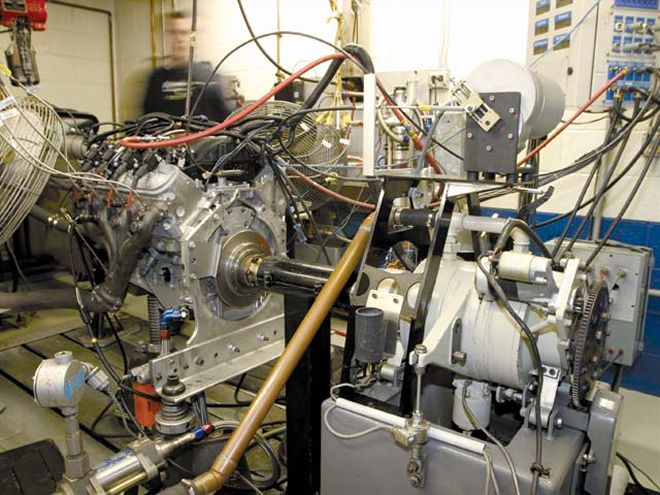 The inside of a Katech dynamometer cell is awe-inspiring to a gearhead not used to state-of-the-art OE-level instrumentation. Air temperature, pressure, and humidity are controlled at all times to maintain repeatability regardless of outside conditions, and more than two dozen operating parameters are measured and recorded during each pull.
The inside of a Katech dynamometer cell is awe-inspiring to a gearhead not used to state-of-the-art OE-level instrumentation. Air temperature, pressure, and humidity are controlled at all times to maintain repeatability regardless of outside conditions, and more than two dozen operating parameters are measured and recorded during each pull.
Getting the new LS2 crate engine, which Katech ordered from GM Performance Parts dealer Scoggin-Dickey Performance Center, running on a dyno takes some doing, because GM integrated more electronic controls into the Gen IV engine's computer, including electronic throttle control (better known as Drive by Wire) and changed the shape and location of several wiring connectors. Katech modified the throttle cable on its dyno's electronic throttle controller to operate a Corvette accelerator-pedal assembly mounted inside the cell, which in turn sends a signal to a factory Throttle Actuator Control (TAC) to operate the electronic throttle body. The TAC also contains the Corvette's cruise-control functions, and the easy three-wire hookup is a good tip for engine-swapping hot rodders who want to set it and forget it on the highway. Off-the-shelf LS1 wiring harnesses won't work without some modifications either, so Katech modified one of its dyno harnesses with a few extra jumpers to match things up. Katech also swapped the LS2's stock 33-lb/hr injectors for a set of GMPP ASA-series crate-engine 36-lb/hr injectors primarily because the older-style injectors use standard LS1-type injector plugs (the ASA injectors are actually the same as those used on L67 supercharged 3.8L V-6 engines). And since GMPP does not offer the LS2 with a standalone computer controller, an '04 LS6 Corvette ECM calibrated to run the same size injectors took its place. Otherwise, we ran the LS2 baseline test in its stock configuration with the factory coil packs, 90mm throttle-body, intake manifold, and stock exhaust manifolds. All testing was done with water temperature held at 185 degrees F and oil temperature controlled to 190 degrees F.
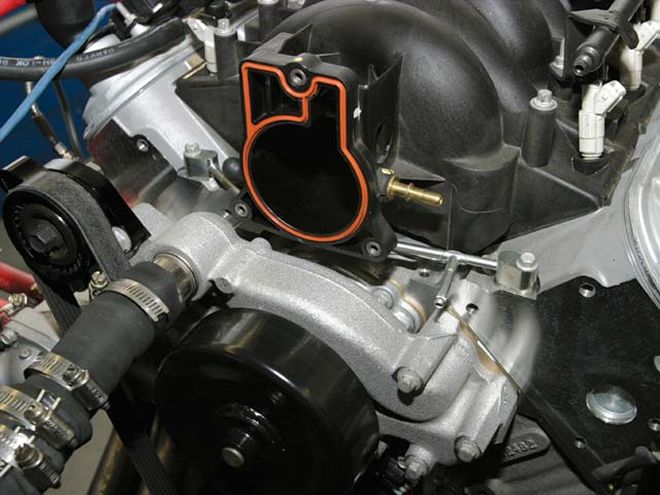 Although the LS6 manifold bolts onto an LS2, there are a couple of hitches. The water-vapor crossover tube that vents the water jackets on each side of the block gets in the way of the LS6 throttle-body. The fix was simply to swap it for an Gen III LS1/6 crossover tube (arrow), which is a direct retrofit. We also had to relocate the driver-side coil-pack bracket to clear the LS6 fuel-rail inlet fitting.
Although the LS6 manifold bolts onto an LS2, there are a couple of hitches. The water-vapor crossover tube that vents the water jackets on each side of the block gets in the way of the LS6 throttle-body. The fix was simply to swap it for an Gen III LS1/6 crossover tube (arrow), which is a direct retrofit. We also had to relocate the driver-side coil-pack bracket to clear the LS6 fuel-rail inlet fitting.
Before we get into power numbers, we should talk about correction factors. In the world of dyno-testing, there are two main correction factors used to standardize results with varying atmospheric conditions: SAE J-1349, which adjusts the prevailing test conditions to 77-degree-F ambient air temperature and 29.92 in-Hg barometric pressure; and SAE J-607 (also known as Standard Temperature and Pressure), which corrects the test data to 60-degree-F air and 29.23 in-Hg barometric pressure. Most OE manufacturers use SAE J-1349 to rate engine output, and those numbers are always given as flywheel horsepower. Most magazines, race-engine builders, and aftermarket companies use STP correction factors when quoting dyno horsepower figures, and the difference between the numbers generated by each is generally about 5 percent of the output as a result of the STP factor correcting to colder air.
Interestingly, in its stock, baseline configuration, the LS2 made exactly 400 hp at 6,000 rpm and 398 lb-ft of torque at 4,400 using the SAE J-1349 factor, right on par with its official GM rating. Converting to STP correction numbers equates to 422 hp and 418 lb-ft. That's a substantial difference, but the point we want to make is that GM is not underrating its engines, it's just rating them differently than most magazine readers are used to seeing. In spite of all of the above, the STP correction factor was used to generate all test results quoted in this article.
CYLINDER HEAD FLOWDescription: Katech CNC-ported LS6 headPN: KAT-AA3825-R01Intake valves: 2.100-inch hollow-stem stainless steelExhaust valves: 1.55-inch sodium-filled stainless steelIntake port volume: 240ccExhaust port volume: 88ccMaximum valve lift w/spring: 0.585-inchMinimum bore dia.: 4.00 inchesList price: $2,759.70 (plus $750 core charge)Intake Exhaust Lift(cfm)(cfm)0.10075510.2001531270.3002181670.4002672070.5003062210.5503232260.5753272280.6003302300.650297232
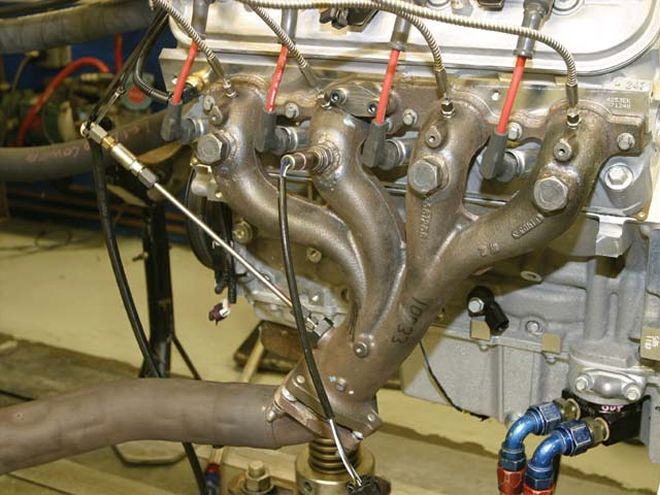 GM has made a big deal out of the reduction of mass in the LS2's exhaust manifolds. The LS6 manifold's free-flowing design was worth 5 hp and 4 lb-ft of torque at the peaks (compared to the stock manifolds), upping output to 427 hp and 422 lb-ft.
GM has made a big deal out of the reduction of mass in the LS2's exhaust manifolds. The LS6 manifold's free-flowing design was worth 5 hp and 4 lb-ft of torque at the peaks (compared to the stock manifolds), upping output to 427 hp and 422 lb-ft.
Over the course of three days at Katech, we tested a variety of configurations, including three sets of exhaust manifolds, three intake manifolds, high-ratio roller rockers, two sets of cylinder heads, and no less than six camshafts. One item, however, did not change: the computer controller. Thanks to the self-adjusting mass airflow electronic fuel injection, we did not need to make any calibration changes to the stock Corvette computer from the baseline all the way up to the 500hp level. That's not to say we couldn't find any power later by tweaking the fuel and timing curves, but it's encouraging to know the computer is not holding us back in our quest to make good old-fashioned horsepower. In fact, we were impressed at just how well the new LS2 responded to our classic bag of tricks, which includes low-restriction exhaust, better-flowing cylinder heads, high-ratio rocker arms, and longer-duration/ higher-lift camshafts.
We ran six cams through the LS2 while it was on Katech's dyno, including the stock cam that uses lobes identical to the '01 LS6 and is ground on the same wide 116-degree lobe separation angle (LSA).
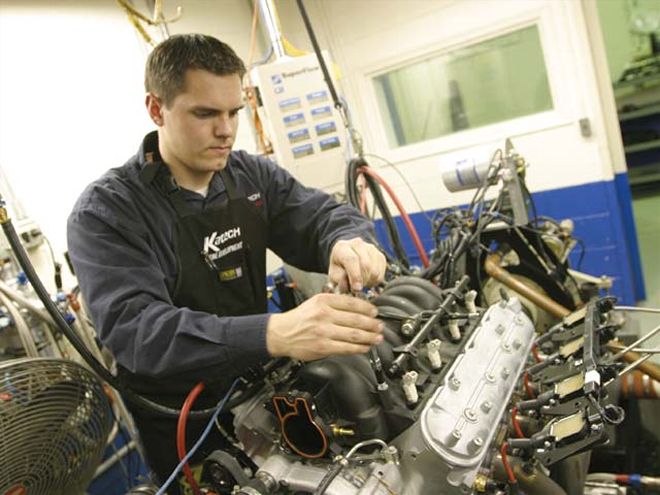 There's been a lot of speculation on the Internet that swapping the LS2's intake manifold with its large 90mm throttle-body might be a hot-ticket setup for older LS1s. Testing that theory, we back-to-back tested the LS2 manifold to an '04 LS6 manifold with its smaller 76mm throttle-body, which is also Drive by Wire. The result: the LS6 design outdistanced the newer LS2 by 8 hp and a huge 16 lb-ft of torque. All the LS1 guys out there scrambling to buy LS2 intakes from dealers might want to reconsider, but if you have a new Corvette, maybe you can trade your intake to someone with an LS6 manifold before he reads this.
There's been a lot of speculation on the Internet that swapping the LS2's intake manifold with its large 90mm throttle-body might be a hot-ticket setup for older LS1s. Testing that theory, we back-to-back tested the LS2 manifold to an '04 LS6 manifold with its smaller 76mm throttle-body, which is also Drive by Wire. The result: the LS6 design outdistanced the newer LS2 by 8 hp and a huge 16 lb-ft of torque. All the LS1 guys out there scrambling to buy LS2 intakes from dealers might want to reconsider, but if you have a new Corvette, maybe you can trade your intake to someone with an LS6 manifold before he reads this.
Next we stepped up to the '02 version of the LS6 cam, which carries a bit more intake duration and a bunch more exhaust duration and lift along with an even wider 117.5-degree LSA. Due to the potential for coil-bind with the valvesprings on the Katech heads, we ran this cam with stock 1.7:1 rockers only, but it was only down about 5 hp and 2 lb-ft compared to the LS2 cam with 1.85 rockers. If you were making the choice between these two options only, we'd suggest going with the SLP 1.85:1 rockers even though they are a bit more expensive, mainly because it's less hassle.
But we weren't done with cams after the stock LS6. Katech has found that the Gen III/IV engines respond very well to increased camshaft overlap by narrowing the lobe separation angle to close the intake valves sooner without increasing duration. Factory Gen III/IV cams are ground with very wide lobe-separation angles to improve emissions and to make the engines less sensitive to exhaust backpressure and exhaust gas reversion.
Narrowing the lobe separation angle effectively advances the intake-valve closing point, allowing the cylinders more time to build compression as the piston rises to TDC. After regrinding the '02 LS6 lobes onto a 112 LSA (about 5.5 degrees narrower than stock) and installing the cam with a 107-degree intake centerline, Katech's modified LS6 cam doubles the overlap area. Narrower LSAs also tend to move the horsepower and torque peaks closer together. In theory, narrowing the LSA without altering the duration of the cam should improve low-end torque due to improved cylinder filling, moving the horsepower peak closer to the torque peak as a result of closing the intake valve sooner. Both predictions came true when we saw torque jump 13 lb-ft to 472 lb-ft at 4,800 after the cam swap with a corresponding 400-rpm drop in the horsepower peak to 466 hp at 5,600 rpm.
Cam Specs DESCRIPTIONPNDUR. @ 0.050VALVE LIFTLSAStock '05 LS212574519204/2110.520/0.520*116Stock '02 LS612565308205/2180.551/0.548*117.5'01 LS6 on 110KAT-4073204/2110.521/0.521*110'02 LS6 on 112KAT-4074204/2180.551/0.548*112Katech CTS-VKAT-4072226/2260.585/0.585**116* with 1.7:1 rockers** with 1.85:1 rockers
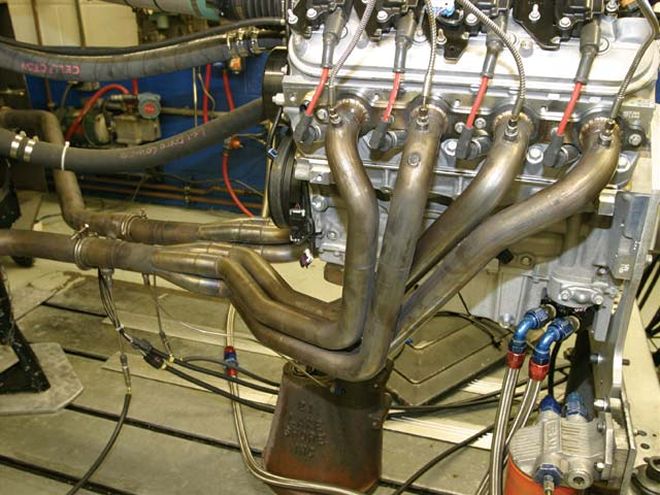 Katech's 13?4-inch stainless steel C5 Corvette street headers were tested with backpressure set to duplicate the factory exhaust system. Peak horsepower remained at 427, but torque increased by 10 lb-ft at the peak and up to 20 lb-ft in the midrange, with an average increase of 8 lb-ft across the entire 2,000-6,400-rpm test range. Dialing back the exhaust backpressure to 6 in-Hg picked up another 8 hp and 5 lb-ft to hit 435 hp and 437 lb-ft.
Katech's 13?4-inch stainless steel C5 Corvette street headers were tested with backpressure set to duplicate the factory exhaust system. Peak horsepower remained at 427, but torque increased by 10 lb-ft at the peak and up to 20 lb-ft in the midrange, with an average increase of 8 lb-ft across the entire 2,000-6,400-rpm test range. Dialing back the exhaust backpressure to 6 in-Hg picked up another 8 hp and 5 lb-ft to hit 435 hp and 437 lb-ft.
Next we tried another variation on the same theme: an '01 LS6 cam reground on a 110 LSA. This cam has essentially the same lobe profiles as the stock LS2 cam, with the intake closing advanced 6 degrees. The big difference between this cam and the previous test is in net valve lift; with 1.7:1 rockers, the '01 LS6 has much lower intensity than the '02 version, opening the intake and exhaust valves only 0.520 inch compared to 0.550 inch for the '02 version in about the same number of degrees of duration. As expected, torque was up about 13 lb-ft compared to the LS2 version of the cam with its wider LSA, but the numbers were down overall compared to the tight-lobe '02 LS6 cam. But that power all came roaring back when we swapped the SLP 1.85 rockers on top of the reground LS2 cam, netting 466 hp at 5,600 and 475 lb-ft at 4,800, nearly duplicating the results of the tight-lobe '02 LS6 cam. Unfortunately, we couldn't run the tight-lobe cam with the 1.85 rockers for fear of coil-binding the springs in the Katech heads. The best choice between the two cam combos would be to run the tight-lobe '02 LS6 cam with the stock 1.7 rockers, or better yet, get some different springs and try both. Keep in mind that with these relatively low-duration cam profiles, this LS2 idles like a stocker at 500 rpm with about 14 inches of manifold vacuum and no modifications to the factory engine computer. It doesn't get any easier than that with late-model EFI performance.
For our last trick, we stabbed in a cam with some extra duration, although we're not exactly talking about bottom-of-the-page specs. Our "big" cam for the purposes of this test is a profile Katech developed for a super-tuned Cadillac CTS-V project car the company built recently.
A single-pattern profile with 226/226 degrees duration at 0.050 and 0.585-inch lift with 1.85:1 rockers on a 116 LSA, this cam was designed to complement Katech's CNC-ported heads on its big 427ci street engines. Turns out the LS2 liked the cam too, just barely missing the magic 500hp mark with 499 hp at 6,000 rpm and 462 lb-ft at 4,800. Not bad for a basically stock engine that purrs like a kitten and runs on pump gas. HRM
Dyno ResultsLS2LS6KatechExhaust*Exhaust*Headers**RPMTQHPTQHPTQHP2,0003611373581373641382,4003531613561623791722,8003822033832044002123,2003932383932394072473,6004062774072784192864,0004143154183174283244,4004183494223524373654,8004173804213844373995,2004064014104054274215,6003884133934194074346,0003704223744273814356,400344419348423351428Average387.6309.6390.2312.2403.0321.7* with 13.0 in-Hg backpressure** with 6.0 in-Hg backpressureLS6 Intake**FAST Intake**RPMTQHPTQHP2,0003611373601372,4003741703681662,8004012144002133,2004072474052463,6004202894212874,0004373324383324,4004483754503764,8004534124614195,2004404344474415,6004164434214486,0003844383954506,400355432366444Average408.0326.9411.0329.9** with 6.0 in-Hg backpressureKatechSLP'02 LS6 Cam CNC Head1.85:1 RRw/1.7:1 RRRPMTQHPTQHPTQHP2,0003561353541353541342,4003731703681683591632,8003952103962103952103,2003952403932393952403,6004122814112814122814,0004243224253224283254,4004473744483754483734,8004554144614214594195,2004414374514454494435,6004244524364644344606,0004014574134704084656,400371451382465378460Average407.8328.5411.5332.9409.9331.0'02 LS6'01 LS6'01 LS6-110 on 112on 110w/ 1.85 RRRPMTQHPTQHPTQHP2,0003711413871473821452,4003851754061854051852,8004252264292284302283,2004242584252594272593,6004393004393014423024,0004483404463404493414,4004683924673894713944,8004724314684274754325,2004594544514464614555,6004384664254524394666,0004064623924474054616,400374456357434374454Average425.7341.7424.3337.9430.0343.5Katech CTS-V w/1.85 RRRPMTQHP2,0003051162,4003401562,8003932093,2003952403,6004082794,0004173184,4004483744,8004624215,2004604555,6004564866,0004374996,400406495Average410.5337.3